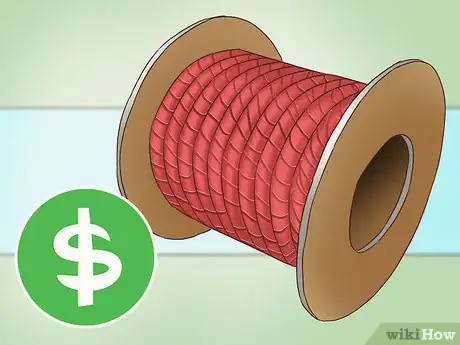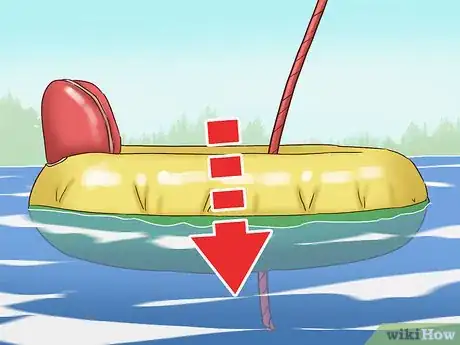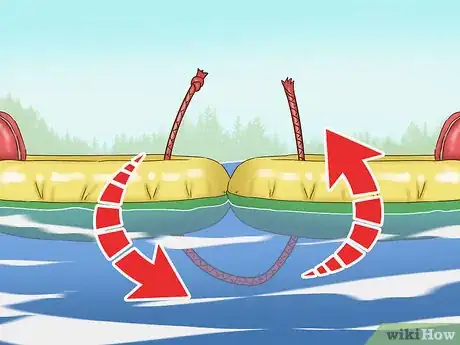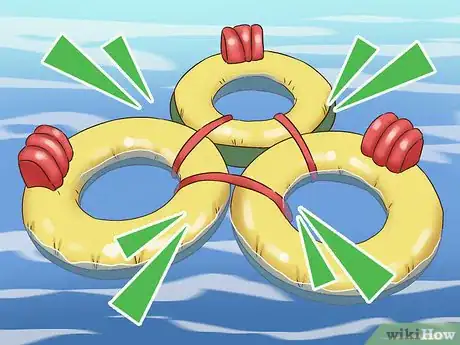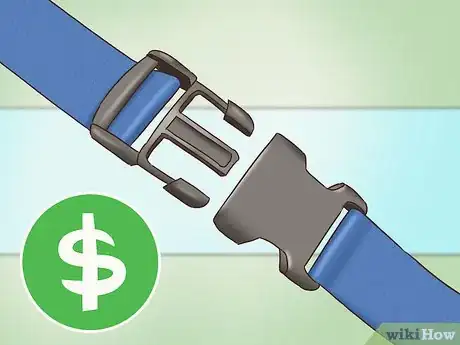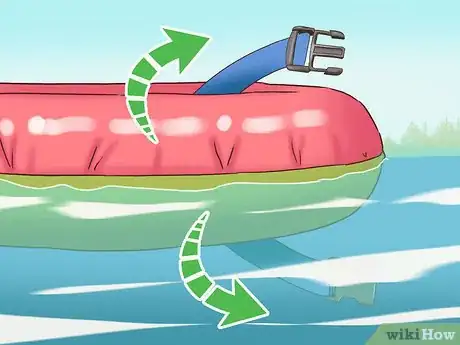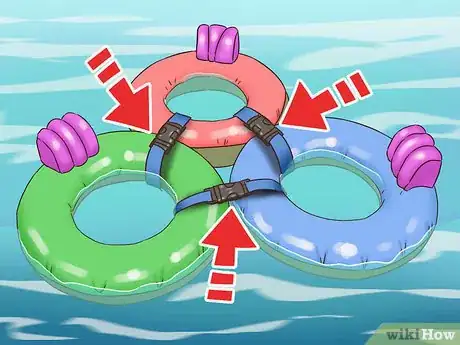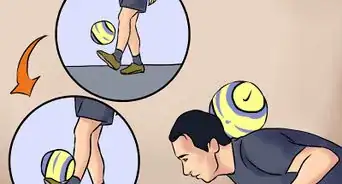X
This article was co-authored by wikiHow staff writer, Hunter Rising. Hunter Rising is a wikiHow Staff Writer based in Los Angeles. He has more than three years of experience writing for and working with wikiHow. Hunter holds a BFA in Entertainment Design from the University of Wisconsin - Stout and a Minor in English Writing.
This article has been viewed 32,827 times.
Learn more...
Floating in a river is a fun summertime activity to do with friends. If you want to stick together with a group rather than floating freely or if you want to keep a cooler with drinks close by, you may want to tie your tubes together. Whether you use robe or plastic buckles, you can have a relaxing day on the water with your friends!
Steps
Method 1
Method 1 of 2:
Using Rope
-
1Purchase braided water-resistant rope. Determine how many tubes you need to connect together. Buy at least 3 to 4 feet (0.91 to 1.22 m) of rope for each tube you’re tied to. Use a rope no thicker than 1⁄2 inch (13 mm) in diameter since it will be more of a burden to tie.[1]
- Rolls of braided rope can be purchased at stores that specialize in outdoor goods.
- Braided rope is commonly used for anchor lines.
- Coordinate with the people you’re going with to see if they can also purchase rope as well.
-
2Measure the distance needed to tie your tubes together and cut the rope. If you have your tubes already, use a flexible tape measure to find out how much rope you need to tie them together. Account for about 4 inches (10 cm) of extra rope on each end so you can tie a knot. Use a pair of sharp scissors or utility knife to cut the rope.Advertisement
-
3Feed the rope through the hole in the middle of your tube. Hold one end of the rope securely in your hand and run the rope through the middle of your tube so it goes underwater. Reach around the outside of your tube with your other hand to grab the part of the rope that’s submerged.[2]
- Work with a friend so they can help hold the tubes in place or grab the rope for you.
- If your tubes have handles, tie the ropes to them to use less material.
-
4Bring the underwater rope through the hole in the second tube. Take the submerged end of the rope and pull it through the hole in the other tube you want to be tied to. Bring the 2 ends of the rope together between the tubes and pull the rope tight.[3]
-
5Tie an overhand knot to keep the rope secure. Form a loop with the end of the rope and then feed the tip through it. Pull the knot tight to keep the tubes secured. Make sure the tubes are not held loosely. If they are, undo the knot, and pull it tighter.[4]
- Tie a double knot for added security.
-
6Tie your tube to any other tube. Depending on the size of your group, you may have 3 or 4 ropes tied around your river tube. Make sure each tube is secured to at least 1 other tube.[5]
- Make a cluster of tubes rather than a straight line. The current can differ in different parts of the river and could pull one of the tubes faster. It also makes it easier to talk and relax with your friends!
- If you have a larger group, split up into smaller groups of no more than 5 people. This helps make it easier if you have to navigate through shallow water or rapids.
Advertisement
Method 2
Method 2 of 2:
Connecting Tubes with Buckle Straps
-
1Purchase buckles with polypropylene webbing 3 to 4 ft (0.91 to 1.22 m) long. Look for buckles that have a male and female end, meaning an end with a buckle and an end that you slide the buckle into. Use a side release buckle for the easiest attachment and release.[6]
- Have at least 2 straps for each tube you’re connecting.
- Find plastic buckles with webbing at hardware stores or stores that specialize in outdoor goods.
- Polypropylene is durable and water-resistant, so it will be easy to handle.
-
2Wrap one buckle around your tube and another around the second tube. Feed one of the ends of the buckles through the hole in the center of each tube. Make sure you feed the opposite into the water for each tube. For example, if you put the male end through one tube, feed the female end through the other so they’re able to clasp together.
- If your river tubes have handles, wrap the straps around them.
-
3Attach the male end of one buckle to the female end of the other. Clip both of the buckles together so they’re secured. If the straps hold the tubes loosely, pull on the webbing attached to the male end of the buckle to tighten the connection.[7]
- Loose straps could be hazardous if you get tangled in them, so make sure you are connected tightly.
-
4Connect all the tubes together in your group. Make sure each tube is connected to at least 2 others so they do not float freely. Attach the tubes so they are in a cluster rather than a straight line so you can easily talk to your friends![8]
Advertisement
Warnings
- Make sure the ropes are secured tightly so you cannot get tangled in them. River currents vary and could drag you under the water.⧼thumbs_response⧽
Advertisement
Things You’ll Need
Using Rope
- Braided water-resistant rope
- Flexible tape measure
- Sharp scissors or utility knife
Connecting Tubes with Buckle Straps
- Plastic buckles with polypropylene webbing
References
- ↑ https://www.fieldandstream.com/articles/hunting/2013/02/best-ropes-hunting-fishing-camping-and-outdoor-survival
- ↑ https://rootsrated.com/stories/tube-salt-river-without-hassles
- ↑ https://itsnothouitsme.com/2016/06/26/how-to-float-the-river-in-texas/
- ↑ https://youtu.be/SwdJ5op25SM?t=6s
- ↑ https://itsnothouitsme.com/2016/06/26/how-to-float-the-river-in-texas/
- ↑ https://itsnothouitsme.com/2016/06/26/how-to-float-the-river-in-texas/
- ↑ https://youtu.be/rMyrND0D8uQ?t=16s
- ↑ https://itsnothouitsme.com/2016/06/26/how-to-float-the-river-in-texas/
About This Article
Advertisement
